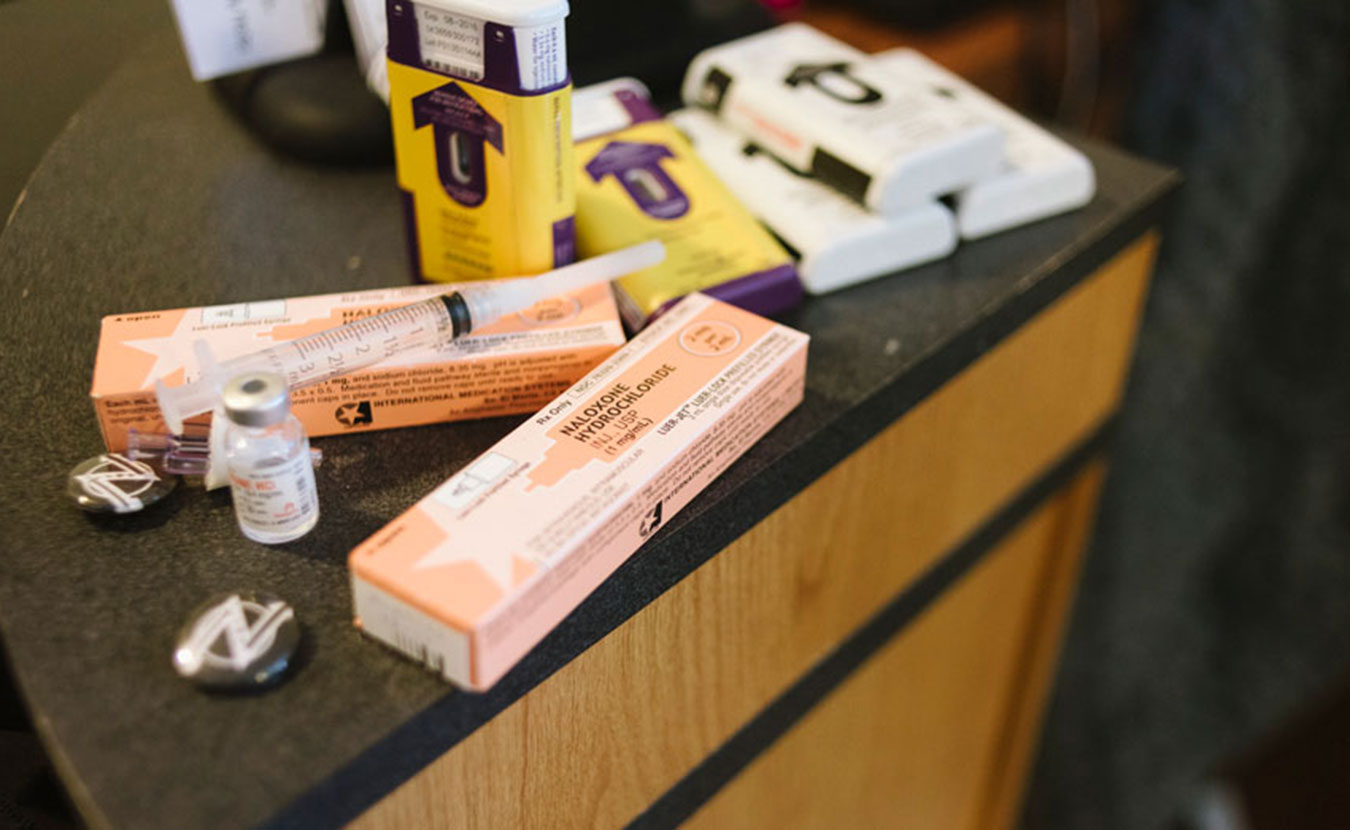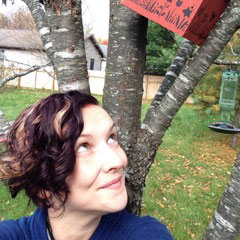- According to the U.S Drug Enforcement Agency, Indiana is one of the top meth-producing states in the nation. Indiana State Police has reported that it has busted nearly 1,500 meth labs every year from 2013 to 2015.
- On March 25, 2015, the Chicago Tribune reported that Scott County, Indiana, experienced the single largest outbreak of HIV in Indiana’s state history due to opiate intravenous-drug use.
- On February 4, 2016, WISH-TV Channel 8 in Indianapolis reported that more than 20,000 children had fallen into the hands of the state because heroin-addicted parents have had to go to treatment or jail and cannot care for their children.

Photos and names of those lost to overdoses are taped to the IRA van during a vigil on August 31. | Photo by Natasha Komoda
- On June 13, 2016, The IndyChannel RTV6, the ABC affiliate in Indianapolis, reported that Amish communities from three different areas in central Indiana had met with each other to discuss the rising use of heroin within their communities.
- In June 2016, President Barack Obama urged congressional leaders to approve up to $19 million in federal funding to Indiana to implement drug-treatment and drug-prevention programs.
- More recently, on August 24, 2016, WTHR Channel 13, the NBC affiliate in Indianapolis, reported 12 overdoses in one day in Jennings County because of heroin laced with fentanyl.
These reports all point to Indiana’s growing drug epidemic. Newer drugs come on the market, older drugs become more potent, and lawmakers — while quick to villainize drug users and continue mass crackdowns — flounder at starting drug-prevention programs. It feels all too familiar — because it is. The United States has been battling a drug problem — and continuously losing — for more than 100 years.
A handful of social-service organizations in southern Indiana are using harm reduction, a new method spearheaded in larger cities, including Seattle and Chicago, in response to the current drug epidemic, to try to reshape the way people think about addiction, drugs, risk, and community health. Christopher Abert, director of Bloomington’s harm-reduction organization, the Indiana Recovery Alliance (IRA), is focusing on reducing the harm to individuals and their communities caused by drug use instead of focusing on merely decreasing the prevalence of drug use. He wants people to rethink their attitudes toward abandoning those who use drugs because abandonment often leads to easily avoidable consequences.

In addition to providing clean intravenous-drug supplies, Christopher Abert, director of Indiana Recovery Alliance (IRA), says he is proud to offer naloxone and overdose-reversal training to first responders. | Photo by Natasha Komoda
“Most people think that drug addiction is simply a matter of poor choices people have made and that they should be punished for those choices — that they should be left to suffer the consequences of their decisions,” Abert says. “Our experience and research show it’s not that simple, that there are genetic and social vulnerabilities at play as well. And we know that 80 percent of heroin users today started with prescription drugs. Harm reduction accepts, for better or worse, that there will always be some amount of substance abuse in our society. It’s been with us since we started crushing grapes. So the question isn’t how to completely eradicate it; the question is how to deal with it compassionately and to mitigate some of the negative social problems and health consequences.”
This approach goes against the traditional practice of solving drug addiction through criminalization. Harm reduction sees addiction and harm on a spectrum and, instead of throwing addicts in jail, provides options and resources to a person struggling with drug addiction.
Harm reduction and public health
The first step in harm reduction is to save lives. The use of naloxone, an instant-acting drug that reverses an overdose, was first introduced a couple of years ago to southern Indiana by Kristi Dunnigan of the Morgan County Drug Task Force. She says distributing naloxone kits to emergency medical service (EMS) agencies in Morgan County has reduced overdose rates.
“Morgan County was the first county in the state to have naloxone training for some 400 EMS people,” Dunnigan says. “Our death rate from overdoses in 2014 was 16 people. In 2015 it dropped to 12. In 2016, so far, it is 7. The first year we had 35 saves within a short period of time.”

“I get so many other resources here besides needles,” says one participant of IRA’s programs. | Photo by Natasha Komoda
Dunnigan developed the initiative after a shocking number of young people died of overdoses. “We started on the naloxone,” she says, “because the deputy sheriff came into the drug task force and said they’d had four deaths in nine days, and they were all young kids under the age of 20.” Since 2014, the Indiana State Health Department has distributed naloxone to 20 counties.
Another component of harm reduction is to make sure intravenous-drug users have access to clean needles. Because of hepatitis C and HIV outbreaks throughout Indiana, the state health department approved free needle exchanges at six locations: one in Monroe county (Indiana Recovery Alliance), one in Scott county, and four in Madison county.
The number of people who contract hepatitis C and HIV is also an economic issue. In Scott County, 190 people contracted HIV in 2013. According to a June 6, 2016, article in the Chicago Tribune, health experts estimate that HIV treatments in Scott County alone will cost the public around $200 million for the treatment of uninsured patients. In Monroe County, Abert says, treatment for the 200 new cases of hepatitis C in the past 12 months could cost $20 million.
Keeping people disease-free is the next step in reducing harm and continuing to seek options toward recovery. Recovery is by no means linear — it is not a neat and easy path to become healthy and safe while recovering from addiction. But in between high-risk behaviors and entering a traditional 12-step abstinence program, a person can take many actions to cause less harm to themselves and to their community. Harm-reduction proponents say one of the most important aspects of harm reduction is to meet individuals where they are and to not pressure them toward abstinence but instead provide resources, support, and alternative options. This de-stigmatizes drug addiction, and, in turn, addicts are more open to seeking treatment. According to a study in the Journal of Substance Abuse Treatment, people are five times more likely to seek treatment if there’s a harm-reduction project in their community.
Beyond rehab
Indiana Recovery Alliance provides naloxone distribution and training, a needle-exchange program, clothes and toiletries, food and water, and, perhaps most important, a welcoming and caring atmosphere for every individual who walks through the door. On a Tuesday afternoon during IRA’s office hours at 118 S. Rogers St., Cindy, a woman in her mid-20s and a participant of IRA’s programs, talked about her own experience of being able to reconnect with her family due to the help she has received at IRA:
“I get so many other resources here besides needles,” Cindy said. “I’ve gotten more solutions here than from my parole officer, from rehab, or from any other social-service center. I started talking to my mom today. I read two poems to her. I’ve said things to family members that I thought I would never say — because of coming here. People don’t judge you here, so I feel like I can be honest about it to my family.”

Abert at work in the IRA store room. An IRA participant, Cindy, says she has received more solutions at IRA than from anywhere else. | Photo by Natasha Komoda
This connection to Cindy’s family is particularly important for her to move toward less-harmful behaviors. As Brandon Drake, founder of Keystone Interventions and a recovery coach, says, connectivity is fundamental to the recovery process.
“We’re not reaching anybody by cutting their connection,” he says. “The goal is: How do we get you to do less harm but also live in a world where you’re accepted and connected and [can] regain those connections instead of threatening those connections.”

Brandon Drake, founder of Keystone Interventions, speaks during a vigil at the Monroe County Courthouse Square. | Photo by Natasha Komoda
This approach has also influenced his methods for interventions when he works with family members. “The old model of intervention is, everyone gathers around the person and you threaten the connection, and you force them into a corner where they have to go get treatment,” Drake says. “And it didn’t work. But then I started taking an invitational approach based on harm reduction. Instead of cutting the connection, I reconnected them to the family whether or not they’re using. It’s not always effective, but it’s more effective than cornering someone and telling them they’re a piece of shit and Mom’s not gonna love you anymore.”
Most advocates say this is the fundamental difference between the traditional approach of treating addiction and harm reduction. It is an approach based on healing rather than criminalizing, empathizing rather than judging, love rather than punishment. The era of tough love, enabling, zero tolerance, and maximum sentencing has caused painful fracturing of families and people drowning in isolation from their addiction.

Attendees light candles during a vigil to remember loved ones lost to drug overdoses. | Photo by Natasha Komoda
On August 31, Drake organized a vigil at the Monroe County Courthouse Square for victims of drug overdoses. Speakers ranged from people representing organizations such as the IRA and Keystone Interventions to those who have lost family members from overdoses to people in active recovery. A recovering addict named Colin spoke about his experience, emphasizing that not being honest with those closest to him impacts his chances of recovering:
“With this disease, you’re only as sick as your secrets,” Colin said. “I don’t know if I will be clean for the rest of my life. And I’ve told my family that. I only know that I can be clean one day at a time.”
A fight for humanity
Advocates agree that harm reduction is challenging. It asks us to go against what we’ve been taught about drug addiction since the start of the war on drugs. It might make you uncomfortable to think about supplying a drug addict with free needles and other safe IV-injection supplies. If a member of your family is struggling with addiction, you may balk at the thought of not forcing them to go into treatment. There may even be a part of you that thinks naloxone is a waste of time because addicts may go back to using after an overdose. Even Drake had mixed feelings when he first encountered a needle-exchange transaction.
“At first I couldn’t do it,” he says. “It hurt. But then I started thinking about it. I started seeing the humanity in it.”

Maintaining connections to family and friends is an important aspect of harm reduction. Colin (center), a recovering addict, says not being honest with those closest to him impedes his recovery. | Photo by Natasha Komoda
To make our communities safer and healthier, people working on the problem say we might have to reshape the way we see addiction, which might require us to ask ourselves some tough questions: Most people consider themselves compassionate, kind, and empathetic people, but how far are we willing to challenge ourselves on that notion? Can you find empathy for people who make different (and possibly what you’d consider to be worse) choices than you? Can you find compassion for people who are not yet willing to seek treatment? If a family member is struggling with addiction but not seeking treatment, would you help them to make safer choices?
These are questions we all have to ask ourselves because addiction is not an isolated occurrence that affects only the user. It ripples throughout families and communities, affecting everyone. Instead of seeing a drug addict as a “criminal element” or an “other” on the street, we can try to see them as they are — your friend, neighbor, or community member who needs help.
Premiere information: On Thursday, September 29, at 8 p.m., Indiana Public Media outlets WFIU/WTIU will premiere the documentary Finding the Fix: Heroin in the Heartland about the growing drug epidemic not just in Indiana but also Ohio and Kentucky. Produced in partnership with a team from Northern Kentucky University, Indiana University, and Franklin College, the documentary addresses harm reduction, interviews active users and drug-court judges, and looks at different options of medicated treatment.






No Replies to "Harm Reduction: A Challenging New Approach to the Drug Scourge"